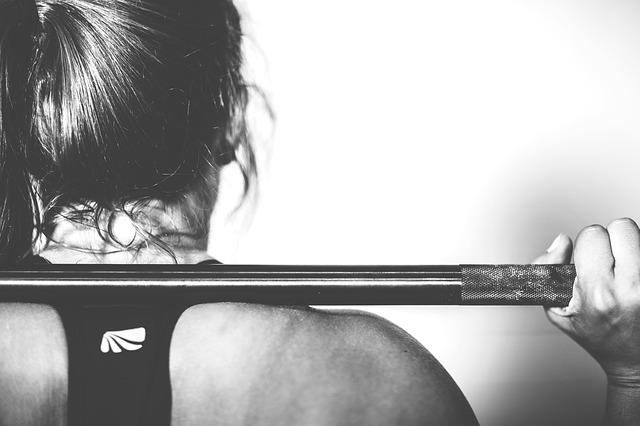Updated March 2021
The notion of losing weight is usually something that people aspire to when they are not happy with their bodies. However, it is more effective to lose fat, not weight, since this allows your muscles to stay strong while your body looks leaner and becomes healthier.
Despite what you may believe about burning fat without losing muscle, it is possible and we have the solutions for you right here.
You may be thinking that fat loss and weight loss are the same thing, but that is where you are mistaken and why you haven’t figured out how to put on muscle while burning fat.
Today, we’re going to guide you through body recomposition, which equates to how to lose fat but not weight.
Why Should You Aim To Lose Body Fat But Not Weight?
When you are aiming to live a healthier lifestyle in your dietary choices and your workout choices, you need to take into consideration why you are making these changes.
If you want to reduce the risk of heart disease, high cholesterol, hypertension, and type 2 diabetes, among other health conditions, you need to reduce your body fat percentage.
If you have chosen to exercise and eat better to be happier with your body and have a better figure, then you will also need to lose fat weight instead of just losing weight.
When you look after and grow your muscles, your body will have a firm and more toned look when the fat shrinks away. This will also reduce the fat build-ups around your internal organs, resulting in a reduced chance of suffering from chronic diseases.
Why Body Recomposition Is Tricky
Everyone’s body composition is different. Some people naturally carry more fat than muscle, while others have a challenge with putting on both lean body mass and fat.
Another factor is “protein biosynthesis,” a process where the cells build protein. This is a part of the overall body maintenance that we unknowingly go through every single day.
This is why the average person who eats their maintenance level of calories and does just enough exercise to keep their current weight and fitness level does not see much fluctuation between fat and muscle.
For the person training hard, however, workouts damage the muscle fibers, and so the process of protein synthesis gets a bit more demanding.
Since the body needs more cells to heal these muscles, the muscles will actually get bigger. Therefore, you need to continuously overload the muscles to keep building more muscle. Otherwise, your body adapts to the work and you plateau.
Now you know why everyone is always telling you to knock back a protein shake after going heavy with the weights, because the more demand you put on your body, the more protein you need in your diet.
But therein lies the problem with “losing fat and gaining muscle.” You need a calorie deficit to lose weight. When you cut calories to burn fat, the body will ultimately reduce overall anabolic hormone levels and the rate of protein biosynthesis. Uh oh!
How Does Recomposition Work Then?
The key is finding a balance between your calorie deficit, nutrition, and workout load.
It starts with figuring out your natural body composition. Which do you gain more easily, fat or muscle? Where do you gain that muscle? Also, take into consideration how old you are and if you have worked out hard in the past.
The body’s natural composition changes as you age, and having previous experience with gaining muscle means you might not see gains as quickly as a newbie would.
Once you have figured out these integral parts of the equation, you can then begin applying the following tips for losing fat and gaining muscle simultaneously:
1. Focus On Heavy Compound Lifting
First, some myth-busting: High volume, medium weight is not ideal for shredding muscle. You’re only working endurance, which does nothing for adding muscle to your body’s frame.
What you need are targeted compound (also called “complex”) exercises that hit the targeted muscle groups that gain muscle quickly.
The more parts of the body you work in one shot, the more you can progressively overload the system.

Examples of compound exercises include the squat, deadlift, bench press, and military press. Isolated exercises like the bicep curl and side lateral raise are not going to put on as much muscle mass.
Now, we said “heavy compound lifting.” What do we mean by that? You need to emphasize heavy weights, usually 80% of your 1RM, which is usually 4-6 or 5-7 reps per set (or about 60-80 reps per muscle group per week). In other words, aim for moderate volume, high intensity.
If you need some workout ideas, use guides that involve compound chest exercises and shoulder exercises to help you gain lean muscle mass.
Check out this video from Buff Dudes on compound exercises:
2. Avoid Excessive Steady State Cardio
Sure, cardio burns calories, but it also does nothing more to the muscle fibers aside from exhausting them.
Steady-state cardio, like jogging on a treadmill for 30 minutes at a moderate pace, actually cuts into your muscle recovery by wearing the ligaments, tendons, and joints. Anything longer than 30 minutes and your muscles may actually catabolize.
Catabolizing refers to the breaking down of a substance and so, when you are in an excessive state of steady cardio, your muscles may break down.
This will result in a reduction in your muscle weight—so the number on the scale may seem like a pleasing result, but it doesn’t help the question we are addressing, which is how to lose fat but not weight.
You want to reduce your body fat percentage to enjoy the health benefits of losing weight the right way. Dropping your muscle mass will only act as a shield to your true goal of wanting to lose fat.
3. Try HIIT Cardio Instead
On the flip side of steady-state cardio is high-intensity interval training, also known as HIIT.
This type of cardio actually works wonders for body recomposition because HIIT has been proven to not only accelerate muscle growth, but also to increase insulin sensitivity in the muscles, increase resting metabolic rate, and cause significant spikes in growth hormone levels.
All of that factors into less fat and more muscle.
However, you don’t want to do too much HIIT, either. Limit your sessions to two to three times a week and no longer than 30 minutes per session. That will be enough to help melt some fat and redefine your physique.
4. Get Pre- And Post-Workout Nutrition On Point
Food is fuel. It is that simple.
You have to maintain a balanced diet that not only prioritizes your recovery but also gives your body the necessary vitamins and nutrients to crush whatever workout comes your way.

You should be eating the appropriate amount of protein needed to aid in protein synthesis as well as getting enough carbohydrates to give you energy for a HIIT session.
5. Do Not Overly Reduce Calories
Yes, you need a calorie deficit to burn fat, but if you reduce those calories too much, then your body is going to go into starvation mode.
Doing so is detrimental to your muscles, which provide the body more immediate energy and are easier to break down than fat.
A moderate deficit, which is about 20% below your body’s needed maintenance level of calories is going to be enough to keep you energized and healthy without compromising your system.
There you have it, the clean-cut truth about body recomposition.
It is not going to be easy, and you are going to have to monitor your progress to make sure you are working as efficiently as possible.
How To Lose Body Fat, Not Weight, With The Right Diet
When you are choosing a healthier lifestyle where you aim to keep your muscle mass up while your body fat drops, you will need to focus on eating the right diet.
Increasing your protein intake will help your muscles build up stronger after strenuous exercise, while reducing the number of unhealthy fats in your diet will help reduce the fat stores in your body.
Monounsaturated fats are the type you want to consume, and these can be found in nuts, fatty fish, flax seeds, and avocados, among other foods. The keto diet is a good option to lose weight with healthy fats.
If you are not getting enough protein in your diet, you can look to supplement with a protein shake after your workouts.
Lose Fat, Not Weight FAQs
How Can You Lose Fat And Not Weight?
If you want to keep your muscle mass up while dropping fat, you will need to exercise strategically by focusing on heavy compound lifting and switching up your usual cardio for a HIIT cardio session.
Can You Structure Your Exercises To Lose Belly Fat?
Including more core-focused exercises can help tone and shape your abdominal area; however, it is not easy to target specific fat areas on your body through exercise, as your body will determine where the fat drops off first. Following a proper training schedule and eating right will help you lose belly fat.
What Foods Are Good For Fat Loss?
If you boost your body’s metabolism, it will help speed up the fat-burning process. There are several natural foods you can consume to promote fat loss and these include fatty fish, coffee, green tea, apple cider vinegar, eggs, and full-fat Greek yogurt, among many others. Including these foods in a well-balanced diet will help your body burn off excess fat.
Before You Get Lifting
Losing body fat is a healthier option than simply losing weight that you see represented by the number on the scale. Understanding how weight is determined by both your muscle mass and your body fat will help you make the right choices when training.
Choose to lose weight for your health and to feel more comfortable in your skin, and through healthy eating and proper exercise, you can enjoy these benefits.
If you have the motivation, you can do anything you set your mind to.
Eat clean, nutritionally balanced meals, use high weight and low volume, and avoid steady-state cardio. By following the guidelines laid out for you, you’ll start seeing more muscles develop and eventually achieve your desired look.





Great tips! I find that HIIT really helps, and even just long walks with a few sprints mixed in is a good way to burn extra calories without totally exhausting the muscles.